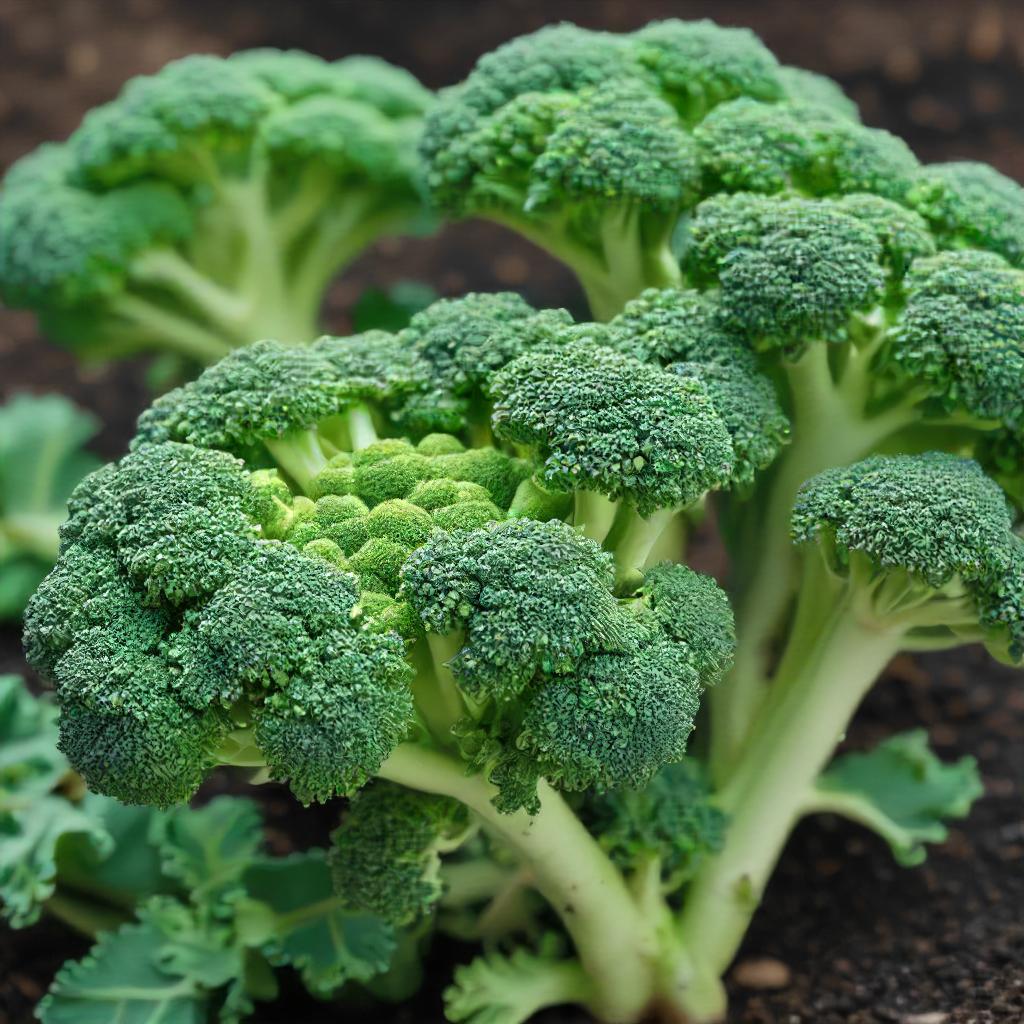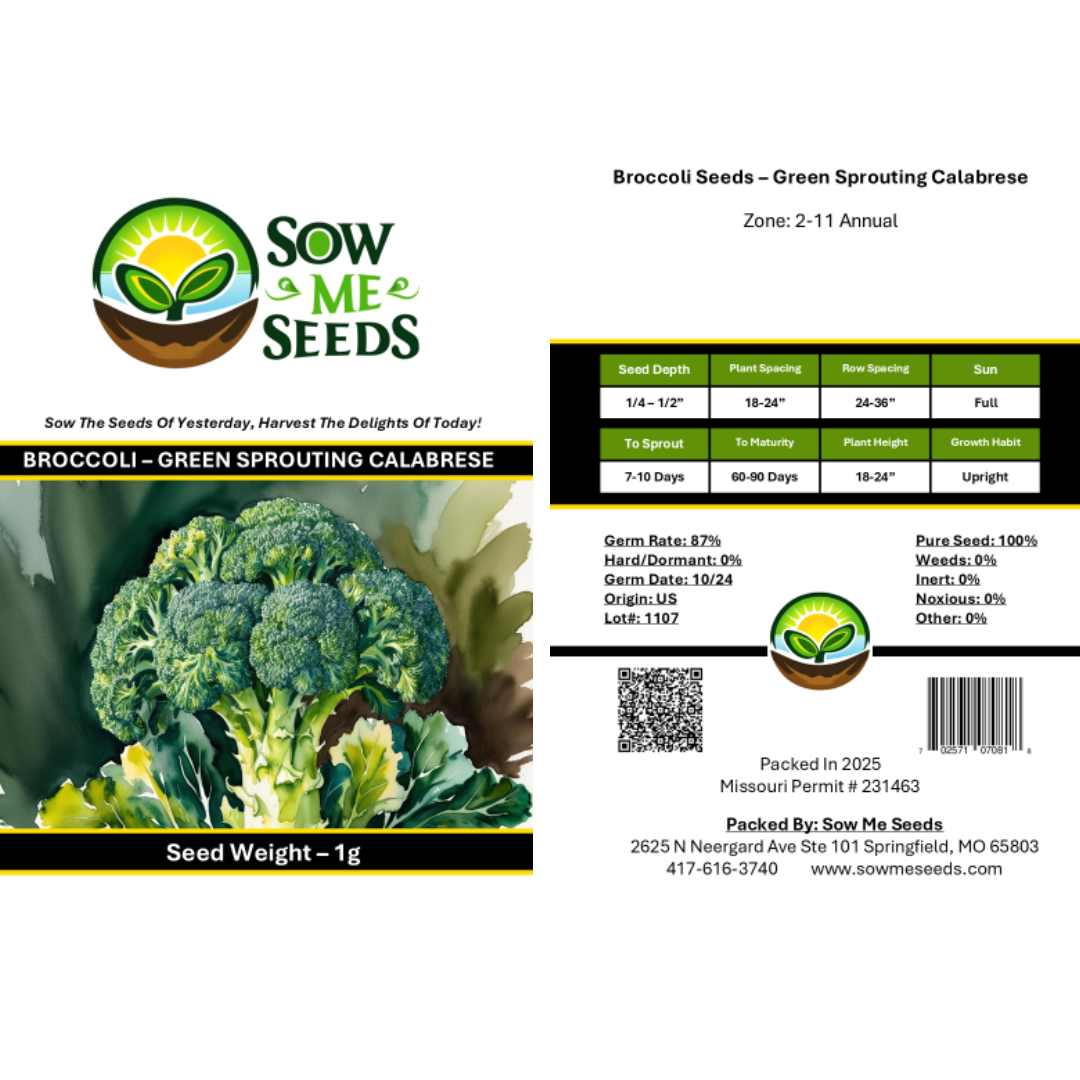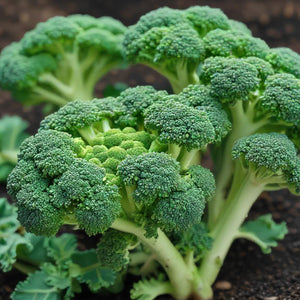- Hardiness Zone: 2-11 Annual
Seed Depth: 1/4–1/2 inch
Seed Spacing: 18–24 inches
Row Spacing: 24–36 inches
Sunlight: Full sun
Days to Sprout: 7–10 days
Days to Maturity: 60–90 days
Growth Habit: Upright annual
Sunlight: Requires full sun, with at least 6–8 hours of direct sunlight daily for optimal growth and head development.
Soil Type: Prefers well-drained, fertile soil with a pH of 6.0–7.5. Enrich soil with compost or organic matter for best results.
When to Plant: Start seeds indoors 6–8 weeks before the last frost for spring crops, or sow directly outdoors in late summer for a fall harvest.
Direct Sowing: Plant seeds 1/4–1/2 inch deep and thin seedlings to 18–24 inches apart once they have true leaves.
Indoor Sowing: Sow seeds in seed trays and transplant when seedlings have 4–6 true leaves and outdoor temperatures are above 50°F.
Succession Planting: Plant every 2–3 weeks for a continuous harvest.
Watering: Water deeply and consistently, keeping the soil evenly moist but not waterlogged.
Fertilizing: Use a nitrogen-rich fertilizer during early growth, switching to a balanced fertilizer as heads develop.
Pruning: Remove yellowing or damaged leaves to improve airflow and focus energy on head production.
Pest and Disease Control: Watch for aphids, cabbage worms, and fungal diseases. Treat with organic solutions such as neem oil or insecticidal soap if necessary.
When to Harvest: Harvest the central head when it is firm, tight, and 4–6 inches in diameter, typically 60–90 days after planting. Continue harvesting side shoots for several weeks after the main head is cut.
How to Harvest: Use a sharp knife to cut the central head, leaving a few inches of stem and foliage for side shoot production.
Seed Collection: Allow some plants to bolt and produce seed pods. Harvest seeds when pods are fully dry.
Storing Seeds: Store seeds in an airtight container in a cool, dry place.
Why You’ll Love It
Extended Harvest: Produces one large head followed by numerous tender side shoots — perfect for multiple pickings.
Cool-Weather Favorite: Thrives in spring and fall gardens with excellent tolerance to light frosts.
Classic Flavor: Offers that traditional broccoli taste — deep, earthy, and slightly sweet when cooked.
Versatile Variety: Great for both fresh eating and freezing, with uniform growth and dependable yields.
Plant Characteristics
Height: 24–30 inches
Growth Habit: Upright with thick stems and broad leaves
Head Type: Compact, dark green heads followed by many smaller side shoots
Days to Maturity: 60–90 days
Hardiness: Cool-season biennial grown as an annual
Flavor and Culinary Uses
Flavor: Mild, earthy, and slightly sweet with a firm, tender bite
Culinary Uses: Delicious steamed, roasted, stir-fried, or added to casseroles, pasta, and soups
Companion Planting Tips
Good Companions: Beets, onions, potatoes, and herbs like dill and chamomile
Avoid Planting Near: Strawberries and pole beans
Bonus Benefit: Produces over several weeks — perfect for gardeners who like to harvest frequently
Common Issues and Solutions
Bolting in Warm Weather: Plant early in spring or late in summer to avoid heat-induced flowering
Cabbage Worms: Use row covers and encourage beneficial insects like parasitic wasps
Small Heads: Provide full sun, rich soil, and consistent moisture for best development
Seeds Per Packet
| 1g | Approximately 320 |
| 5g | Approximately 1,600 |
Why You’ll Love It
Extended Harvest: Produces one large head followed by numerous tender side shoots — perfect for multiple pickings.
Cool-Weather Favorite: Thrives in spring and fall gardens with excellent tolerance to light frosts.
Classic Flavor: Offers that traditional broccoli taste — deep, earthy, and slightly sweet when cooked.
Versatile Variety: Great for both fresh eating and freezing, with uniform growth and dependable yields.
Plant Characteristics
Height: 24–30 inches
Growth Habit: Upright with thick stems and broad leaves
Head Type: Compact, dark green heads followed by many smaller side shoots
Days to Maturity: 60–90 days
Hardiness: Cool-season biennial grown as an annual
Flavor and Culinary Uses
Flavor: Mild, earthy, and slightly sweet with a firm, tender bite
Culinary Uses: Delicious steamed, roasted, stir-fried, or added to casseroles, pasta, and soups
Companion Planting Tips
Good Companions: Beets, onions, potatoes, and herbs like dill and chamomile
Avoid Planting Near: Strawberries and pole beans
Bonus Benefit: Produces over several weeks — perfect for gardeners who like to harvest frequently
Common Issues and Solutions
Bolting in Warm Weather: Plant early in spring or late in summer to avoid heat-induced flowering
Cabbage Worms: Use row covers and encourage beneficial insects like parasitic wasps
Small Heads: Provide full sun, rich soil, and consistent moisture for best development
Seeds Per Packet
| 1g | Approximately 320 |
| 5g | Approximately 1,600 |




Share and get 15% off!
Simply share this product on one of the following social networks and you will unlock 15% off!